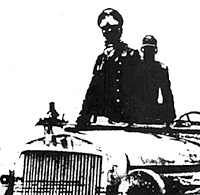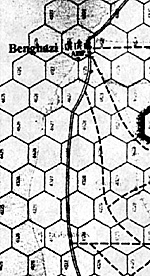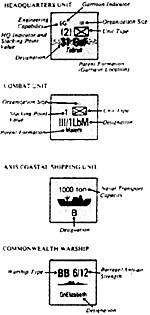 The Campaign for North Africa: The Desert War 1940-43
(CNA) was designed by Richard Berg, developed by Martin
Goldberger and produced by SPI in 1979.
The Campaign for North Africa: The Desert War 1940-43
(CNA) was designed by Richard Berg, developed by Martin
Goldberger and produced by SPI in 1979.
The research team consisted of 14 people, including such luminaries as Howard Barasch, Vance von Borrhies (sic), Frank Chadwick, Dave Isby and Al Nofi. The playtesting team consisted of 20 people, including Brandon Einhom (who has contributed to Simulacrum) and disavows any memories whatsoever of the experience.
Background
From the CNA rulebook:
- "[1.0] INTRODUCTION
The Campaign for North Africa is a simulation of operations in Libya and Egypt from 1940 through early 1943. CNA was designed as a definitive simulation; it was intended for the sophisticated wargamer and the serious student of history. As such, CNA is the most logistically-oriented game ever designed and may be considered by some to be overly complex. ... Very little has been abstracted; CNA contains more hard information on the subject than any other single source encountered by the SPI design staff.
 Each hex represents approximately eight
kilometers; each Game-Turn represents one
week of 'real' time. Units range in size from
companies (approximately 100 men) to divisions
(15,000)."
Each hex represents approximately eight
kilometers; each Game-Turn represents one
week of 'real' time. Units range in size from
companies (approximately 100 men) to divisions
(15,000)."
[2.3] HOW TO RUN A GAME OF CNA
Two years worth of playtesting experience has left us with the consensus that the optimum number of players for a game of CNA is between eight and ten - four or five per side."
[2.4] PLAYING TIME
To play the entire course of Campaign for North Africa will take at least twelve hundred hours (that's 1200)! Probably more, and that's just playing time. Each Game-Turn takes about 10 hours, perhaps less when there is little movement or combat (we have completed a full GameTurn in under two hours, but that was because both sides were logistically exhausted)."
[64.76] The levels of Victory are as follows. Again, anyone who actually finishes this game can consider himself a winner (much as the soldier who fights two-three years does when he survives.) Questions about the balance of the campaign scenario received before 1981 will be considered with the seriousness which they deserve. ... Even ration (1 to 1) - Draw (My God, what a waste of time!)"
DESIGNER'S NOTES: In Brief
What I wanted was a system that would enable units to move as far as the player wanted them to, but within the limits of fuel and fatigue. And I found the germ for such an idea in an unlikely place: Mick Uhl's Gettysburg '77. From that game came the general idea for the Continual Movement System. ... After the movement system fell into place it took several weeks to come up with a combat system. The idea was to provide a tactical feel with an operational game. (The system for CNA is remarkably similar to Frank Chadwick's Operation: Crusader.) ... The morale system was taken from my own Veracruz, another unusual source. ... The main question with CNA is, "Why?" The answer, superficially, is because that's what the feedback said you wanted. But that's a cop- out. I did CNA as a definitive and informationally overpowering simulation because I wanted to see how far I could take simulation gaming and still survive. CNA is virtually unplayable - as a game. It is, for the most part, a source of information. ... A word as to the accuracy of all this information. Let's face it, I am not the definitive scholar on North Africa - it's not even my main area of interest. There are bound to be some mistakes, some all- too-subjective assumptions, and some pure baloney."
Components
one 48 page (8 1/2"x11") Land Game
Rules of Play booklet;
one 44 page (8 1/2"x 11") Air&
Logistics Games Rules of Play and
Scenarios booklet, including five pages of
countersheet reproductions;
two 16 page (8 1/2"x 11") Charts&
Tables Common to Both Players booklets; +
one 16 page (8/2"x 11") Historical
Background booklet by Albert Nofi with
Richard Berg and James Dunnigan,
one 36 page (8 1/2"x11") Axis
Exclusive Charts & Tables booklet;
one 32 page (8 1/2"x 11") Charts &
Tables Exclusive to the Commonwealth
Player booklet;
one 22"x34" sheet of Log Sheets
including, on side 1:
- POW Control sheet
Naval Log Convoy sheet
Air Mission Control sheet
Field Commander Control sheet
Brigade TOE
Vehicle Repair Control sheet
Squadron Ground Support Unit sheet
Supply Dump Control sheet
on side 2:
- Infantry Division Log sheet
Armored Division Log sheet
Trucks & Major End Items Control sheet
Forces Supply Summary sheet
Supply Requisition Form
nine sheets of 1/2" counters at 200
counters per sheet;
two black plastic storage trays with
clear plastic lids, with 20 compartments
per tray;
1d6 3/8" and 1d6 5/8"
five 22"x34" mapsheets labelled A to E,
forming a total area 34"x 110"; and,
one large detergent-style box 4" deep.
Counter Manifest
 Countersheet sections I through 8 were
printed on one side only; countersheet section
9 was printed on both sides.
Countersheet sections I through 8 were
printed on one side only; countersheet section
9 was printed on both sides.
- Sheet # : Nationality Color Qty
1 Italianblack on cream 200
2 Italian black on cream 200
3 Italian black on cream 60
Blackshirts orange on black 54
Neutral black on orange-yellow 66
German black on ochre 20
4 German black on ochre 200
5 German black on ochre 10
Axis markersblack on grey 90
Neutralblack on orange-yellow 40
Alliesblack on orange 29
New Zealandyellow on orange 23
Commonwealth orange on white 8
6 Commonwealth orange on white markers 200
British white on red 200
8 British white on red 26
Indian black on dark red 70
South African red on khaki 43
Australian black on red 45
Commonwealth orange on white markers 161
9 Axis markers black on grey 72
Neutral markers black on orange-yellow 90
Allies markers black on white 38
Commentary
I have my doubts that anyone has managed to play the campaign scenario from beginning to end, and so there is no threat of a review being prejudiced by the prior play of the game.
But as Bob Campbell said in Phoenix 24: "So, does CNA work as a simulation? ... Except under unusual circumstances, I do not think it does, yet it certainly works, if not as a simulation. It is heuristic, it does lead to discovery and understanding. It does so almost entirely in its logistic and housekeeping rules".
Jon Freeman said "CNA is not a game, and to consider it as such is a big mistake. It's a history lesson - a pure simulation. On that level, it is quite an achievement; for people looking for a good 'game', it is totally worthless. It's an all- consuming project".
In Moves 49, Thomas G. Pratuch thought the game so large "that it defies immediate analysis of the tactical and strategic 'planning necessary to win". Similarly, in Fire & Movement 21, Gary Charbonneau said: "You may have heard rumors that this game would be unplayable. It is."
In its WW2 Anthology of strategic Mediterranean theatre (sic) games in Fire & Movement 60, CNA was rated as 'mildly flawed', no doubt due to the value of its orders of battle and its innovative mechanics.
To give Jim Dunnigan the final word: "It's probably the most detailed and tedious campaign game ever produced. The frightening aspect of this game is that we had no trouble getting play testers for it."
So why produce a game which is unplayable? Well, apparently the feedback responses that governed Jim Dunnigan and SPI indicated that gamers wanted such monster games. And true to the old curse, gamers got what they asked for. This is likely the single biggest difficulty with reader feedback - everyone knows what they want, but few know what they need. This was the first, and last, game in SPI s Heuristic Intensive Manual Simulation Series.
Collector's Value
In the first edition of Mark Boone's Internet Wargames Catalog, CNA sold at auction for a low of $55, a high of $150 and an average price of $105.60, while straight sales showed a low of $145, a high of $350 and an average of $219.60. In the second edition, CNA's auction prices increased slightly (low of $55, high of $160 and average of $117) whereas its straight sale prices decreased ($75, $350 and $210.90).
Although there continues to be a small but steady demand for CNA, it is probably safe to say that its value has peaked, and most collectors who badly wanted a copy have now got theirs. The high values should be treated as all-time highs, and even the average values are probably still a bit high for this game.
Other Games of This Type
There are many games which simulate the North African campaign during WW2 (Ozz. Simulacrum 1), including some which cover a greater time span, but there is no other game which comes close to the complexity of CNA. GDW's Operation Crusader is the nearest in terms of complexity, and its logistics system is much more detailed than normal but nothing like CNA's.
The Gamers' recent DAK comes closest to CNA in terms of size. The five maps cover an area 33"x110" at five miles (the same eight kilometers as CNA) per hex; there are five and a half sheets of counters containing 1540 double-sided counters; there are three major rulebooks at 40, 48 and 64 pages respectively, with several pages of charts and tables; there are 2d6; there are four plastic counter trays, and it all comes in a 4" detergent-type box.
Other Games by Richard Berg
This is a thankless task, as Mr. Berg's design credits for SPI alone include Bloody April, the Conquerors, Conquistador, Constantinople, Corinth, the Crusades, Desert Fox, Gondor, Hooker & Lee, SPI Baseball, SPI Football, Terrible Swift Sword, Vera Cruz and the War of the Ring,
He also did Battle of Shiloh and Druid for West End Games, Birth of a Nation, the Horse Soldiers, Manchu and Sideshow for 3W, Blackbeard for Avalon Hill, Chancellorsville: Pinnacle of Victory for Clash of Arms, Dead of Winter for SDC, 1862 and First Blood for SDI, Gleam of Bayonets, Hastings, Julius Caesar, Rebel Sabers, Soldiers of the Queen and 13 Colonies in Revolt for TSR, Murfreesboro for Yaquinto, and Rio Grande for Decision Games.
They did not have hard data on a lot of things, and made up a lot. They
estimated and used rough, reliable figures. They felt that, given the detail, no one
would notice and they could explain away errors of 25% or less.
There was no shortage of playtesters, true, but there was also a high turnover.
The errata (called addenda by SPI) as of September 1979 for CNA were extensive, covering four letter-sized pages. Copies are available for a nominal cost from the SGS.
References
Boone, Mark; Internet Wargames Catalog;
Fredericksburg, 1996.
Boone, Mark; Internet Wargames Catalog:
2nd Ed.; Fredericksburg, 1998.
Dunnigan, James F.; The Complete
Wargames Handbook; New York, 1980.
Freeman, Jon; The Complete Book of
Wargames; New York, 1980.
Palmer, Nicholas; The Best of Board
Wargaming; New York, 1980.
Slizewski, Tom; Wargame Collector Is
Guide: 2nd Edition; Arvada, 1993.
Zocchi, Lou & Costikyan, Greg; Zocchi's
1993 SPI Designers & Chronology List.
Back to Simulacrum Vol. 1 No. 2 Table of Contents
Back to Simulacrum List of Issues
Back to MagWeb Master Magazine List
© Copyright 1998 by Steambubble Graphics
This article appears in MagWeb (Magazine Web) on the Internet World Wide Web. Other military history articles and gaming articles are available at http://www.magweb.com